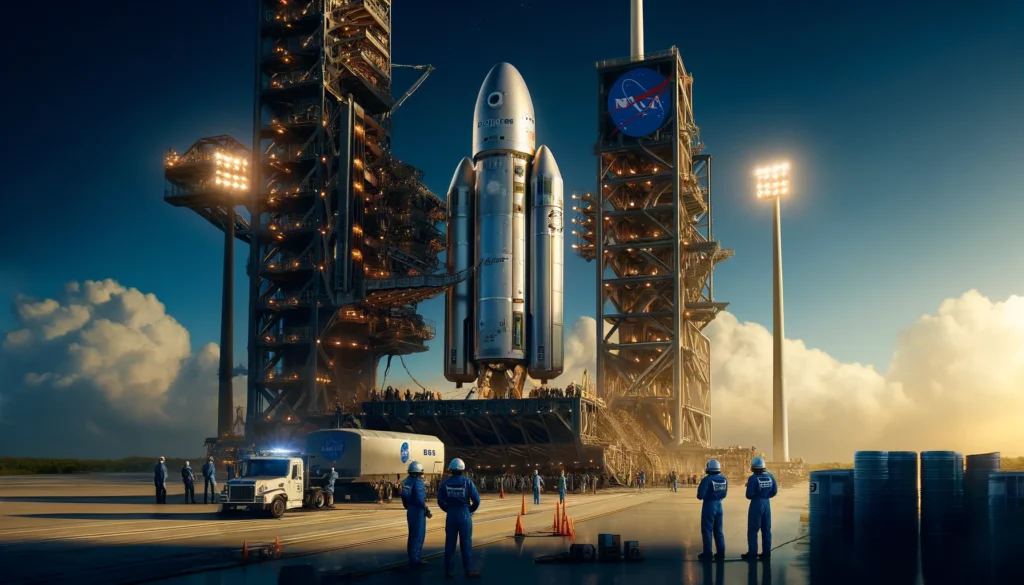“Boeing Starliner, Atlas V Rocket, Commercial Spaceflight, NASA, International Space Station, Crew Flight Test, Space Exploration, Aerospace Technology, ULA, Human Space Travel”

Introduction:
In an era marked by significant advancements in space technology, the Boeing Starliner spacecraft’s rollout to the Atlas V rocket represents a pivotal milestone in commercial spaceflight. This event not only underscores the technical prowess and collaborative efforts in the aerospace industry but also sets the stage for the much-anticipated first astronaut launch aboard a privately developed spacecraft. This article delves into the details of the Starliner’s journey to the launch pad, its implications for the future of space travel, and the broader objectives of this historic mission.
The Rollout of Boeing Starliner:
The recent rollout of the Boeing Starliner spacecraft to the Atlas V rocket is a visual testament to years of meticulous engineering and strategic partnerships. The spacecraft, developed by Boeing in collaboration with NASA’s Commercial Crew Program, was carefully transported to the launch site at Cape Canaveral, Florida. This marks a significant step forward in preparing for the upcoming crewed missions to the International Space Station (ISS).
Technical Specifications and Design:
The Boeing Starliner is designed with the latest technology to ensure safety, efficiency, and comfort for its crew. It features a reusable crew capsule that can accommodate up to seven astronauts. The spacecraft is equipped with wireless internet, touchscreen interface controls, and environmentally controlled systems, making it a modern habitat for astronauts during their journey. Its compatibility with the Atlas V rocket, one of the most reliable launch vehicles in the industry, further enhances its robustness and reliability.
Importance of the Atlas V Rocket:
The Atlas V rocket, developed by United Launch Alliance (ULA), is renowned for its precision and reliability, having launched numerous payloads for military, scientific, and commercial purposes. The selection of the Atlas V to launch the Starliner is a testament to its impeccable track record. The rocket’s configuration for the Starliner mission includes a dual-engine Centaur upper stage, which provides the necessary thrust and control to precisely deliver the spacecraft into orbit.
Objectives of the Mission:
The primary objective of the upcoming mission, designated as Boeing’s Crew Flight Test (CFT), is to demonstrate the spacecraft’s ability to safely transport astronauts to and from the ISS. This mission is crucial for NASA’s goals of increasing access to the space station and fostering commercial participation in space exploration. The success of this mission will validate the design and operational capabilities of the Starliner, paving the way for regular crewed flights.
Implications for Commercial Spaceflight:
The rollout of the Boeing Starliner signifies a new era in space exploration where private companies play a pivotal role. This transition towards commercial spaceflight aims to reduce costs, increase efficiency, and open up new opportunities for space travel. With companies like Boeing and SpaceX leading the charge, the industry is witnessing a shift from government-exclusive space missions to a more inclusive and collaborative space exploration environment.
Challenges and Expectations:
While the rollout is a significant achievement, it comes with its set of challenges. Previous tests and uncrewed missions have presented obstacles that needed to be addressed, such as software glitches and parachute system issues. The upcoming crewed mission is expected to address these challenges head-on, providing valuable data to refine the spacecraft’s design and operations.
The Future of Space Exploration:
The successful integration of the Starliner with the Atlas V rocket and its subsequent missions will have far-reaching effects on the future of space exploration. It will not only support NASA’s objectives of maintaining a consistent human presence in space but also contribute to the long-term goal of exploring beyond the ISS, including missions to the Moon and eventually Mars.
Conclusion:
The rollout of the Boeing Starliner to the Atlas V rocket is more than just a preparation for an upcoming launch; it is a historic moment in the annals of space exploration, symbolizing human ingenuity and the relentless pursuit of expanding our horizons. As we stand on the brink of a new era in space travel, the collaboration between Boeing, NASA, and other stakeholders in the aerospace industry continues to inspire and propel us towards a future where the cosmos is within our reach. This mission, therefore, is not just about testing a new spacecraft but about making history and laying the groundwork for the next generation of space exploration.
Read More-
